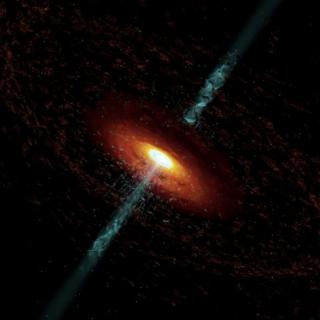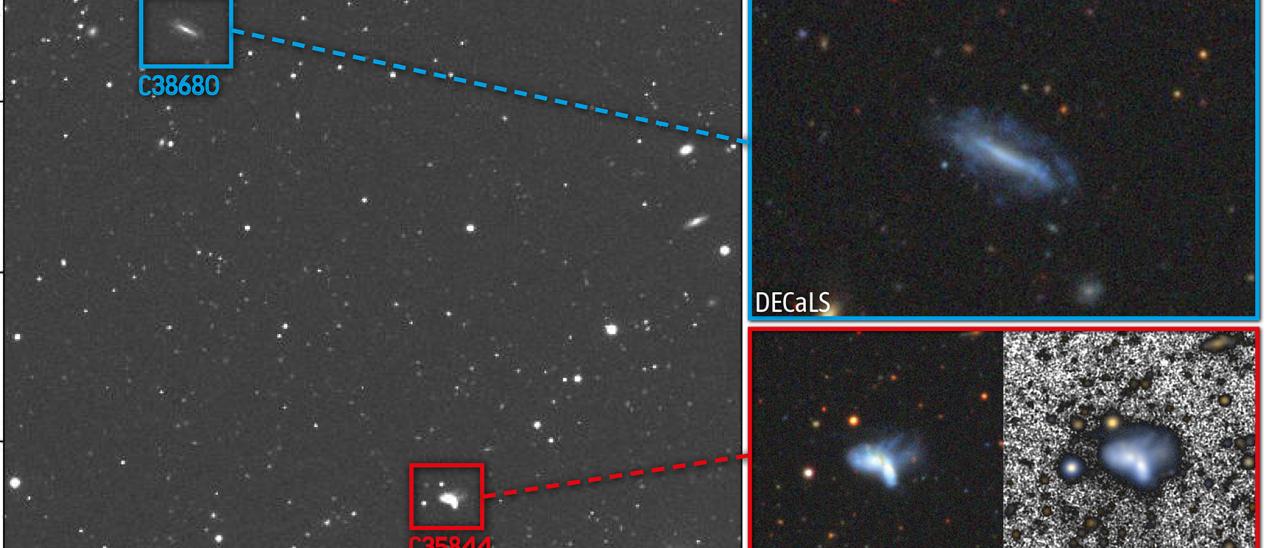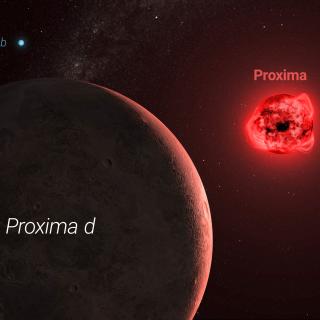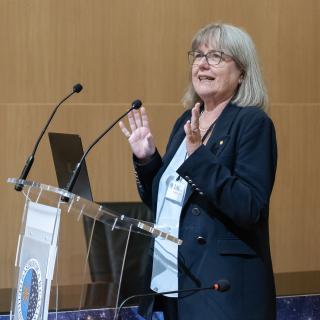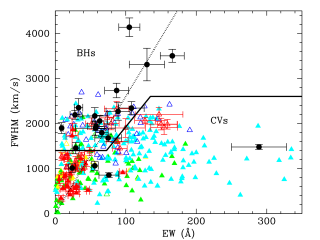Image of a rare pair of interacting dwarf galaxies, observed by the CAVITY project. The two main galaxies, CAVITY35843 and CAVITY35844 (red box), show clear signs of interaction, such as bright nuclei and tidal tails. A third galaxy, CAVITY38680 (blue box), is also visible, located at a great distance from the main pair and which may have triggered the merger. The images come from the Isaac Newton (INT) telescopes and the DECaLS survey.
An international team of researchers, including researchers from the IAC, have studied in detail a remarkable couple of dwarf galaxies “dancing with each other” inside an unpopulated area of the Universe. This uncommon pair of low-mass galaxies merging “in the middle of nowhere”, near the center of a cosmic void, offers a unique view of one-on-one interactions and of the evolution of galaxies located in very low density environments.
Researchers from the Calar Alto Void Integral-field Treasury surveY (CAVITY) project, led by the University of Granada, have discovered a rare and ongoing merger between two dwarf galaxies located deep inside a cosmic void, one of the least populated regions of the Universe.
Galaxy mergers are powerful events that are key in shaping how galaxies grow, change, and form new stars. When galaxies collide, gravitational forces cause them to exchange gas and stars, trigger bursts of star formation, and alter their structures. While mergers between massive galaxies have been widely studied, catching such an event between low-mass dwarf galaxies is extraordinarily rare, especially in such a void environment.
Two to Tango
For the first time, this study presents a detailed analysis of an ongoing merger event near the centre of a cosmic void, involving two dwarf galaxies of nearly equal stellar mass. In terms of ordinary matter (stars, gas, and dust), each of these dwarves is less than a twentieth of the mass of the Milky Way (once more, dark matter apart), our own spiral galaxy hosting the Sun and over a hundred billion of other stars.
“This merger is unusual in several ways,” explains Bahar Bidaran, lead author of the study and postdoctoral researcher at the University of Granada. “Most mergers occur in dense group environments or involve unequal mass pairs. However, this system does not follow either of those patterns. We speculate that the global dynamics of the void, or perhaps a past three-body interaction involving another nearby dwarf galaxy, may have triggered this unique encounter”.
The merging system has a combined stellar mass of just under 10 billion solar masses. The team detected rotating gaseous disks and strong ionised gas emission, signatures of a starburst likely sparked by the merger. Thanks to the favorable alignment of the system along the line of sight, the researchers were able to measure the dynamic mass of each of the merging progenitor galaxies. In addition, deep optical imaging from the Isaac Newton Telescope, located at the Roque de los Muchachos Observatory on La Palma, revealed a striking dust distribution: two connected arc-like structures that may have formed from shock fronts produced during the merger. Based on the data, the two progenitor galaxies were likely disk-like and star-forming, typical of those found in voids.
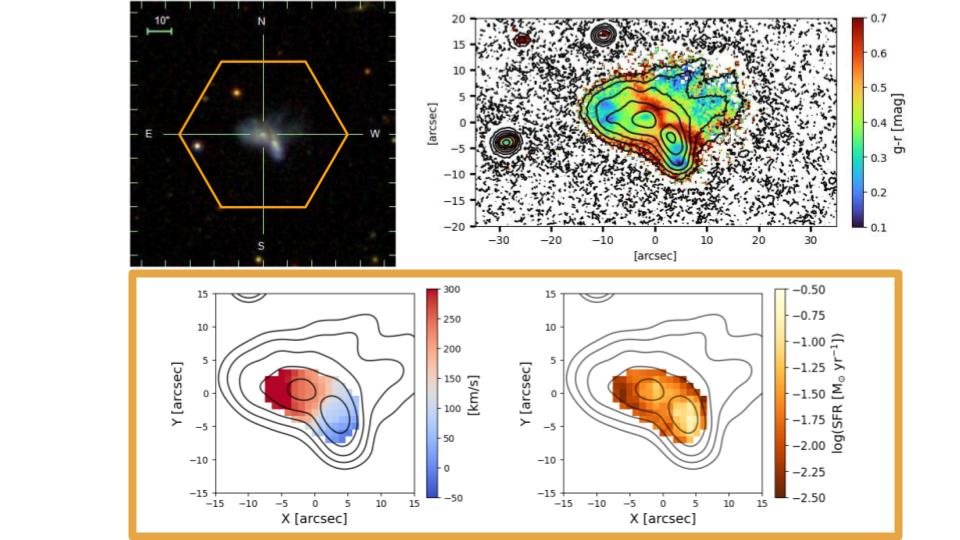
This discovery opens a valuable window into understanding how galaxies evolve in extremely low-density environments, far from the crowded cosmic web where most galaxy interactions occur. “This merger is a striking reminder that even in the loneliest regions of the cosmos, galaxies can undergo dramatic transformations,” says Jesús Falcón-Barroso, a researcher at the IAC and co-author of the work. “Observing such a rare event in a cosmic void gives us a crucial piece of the puzzle in understanding how structure forms and evolves in the Universe’s most under-explored environments.”
A detailed view from Calar Alto
The two dwarves were observed for the CAVITY team with PMAS, the Potsdam Multi-Aperture Spectrograph installed on the 3.5 m telescope at Calar Alto, the largest in mainland Europe. Thanks to the large field of view of PMAS in its PPAK fibre bundle mode (see figure), both small galaxies were observed in a single pointing encompassing the central area of the merger until their very outskirts, sampled by over 300 PPAK sensitive fibres. Each of these fibres provides a spectrum covering the full visible wavelength range, allowing us to study the chemical species, age, and velocities of the matter in every one of the 300 points of the area sampled by PPAK. That is, PMAS offers a complete view of the physics at play in this one-on-one, strong interaction between small galaxies located well inside a void, thus not influenced by a third party.
Anna Ferré-Mateu, co-author of the publication, emphasizes the power of the survey: "Thanks to CAVITY we will now be able to further investigate the stellar populations and formation histories of such rare events in such remote environments, with deep implications on how galaxies form and evolve in the Universe"
The CAVITY team’s findings not only offer new clues about dwarf galaxy formation and interaction but also highlight the remarkable capabilities of the PPAK integral-field unit and the 3.5-meter telescope at Calar Alto Observatory. The instrument’s wide field of view and fine spatial resolution were key to detect this merging system's faint, compact signatures, features that would be nearly impossible to identify without high-resolution observations.
This study also highlights how observations combined with powerful ground-based facilities such as Calar Alto and the Canary Islands Observatories can push the boundaries of the understanding of galaxy evolution in the most elusive corners of the Universe.
Article: Bidaran et al. Rendezvous in CAVITY: “Kinematics and gas properties of an isolated dwarf-dwarf merging pair in a cosmic void region”, 2025, Astronomy & Astrophysics. DOI: 10.1051/0004-6361/202453556
Contacts at the IAC:
Anna Ferre-Mateu, anna.ferre [at] iac.es (anna[dot]ferre[at]iac[dot]es)
Jesús Falcón Barroso, jesus.falcon.barroso [at] iac.es (jesus[dot]falcon[dot]barroso[at]iac[dot]es)

